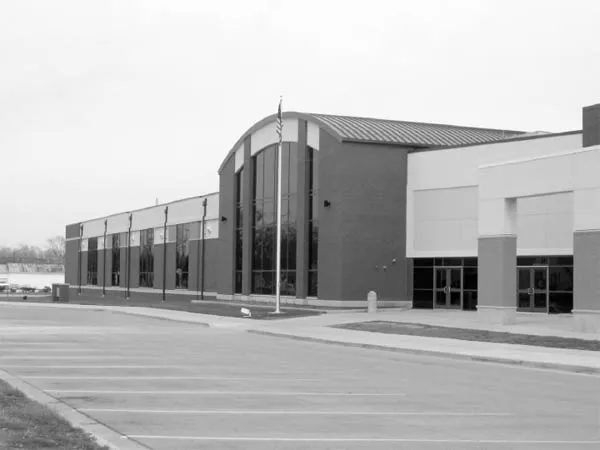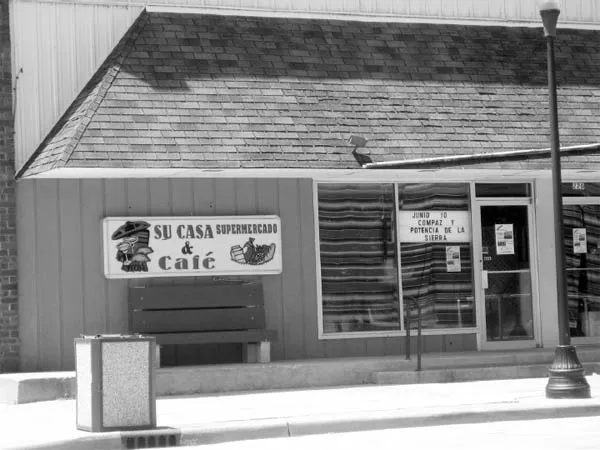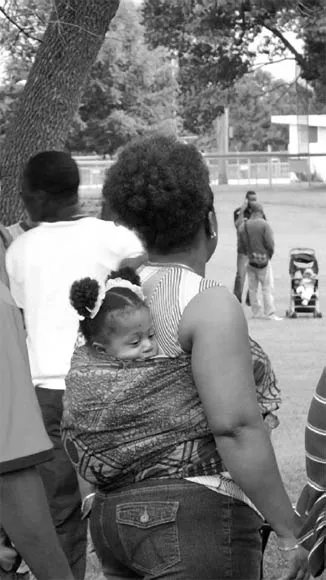![]()
PART I
BEARDSTOWN:
A PLACE IN THE WORLD
![]()
1 WELCOME TO PORKOPOLIS
BEARDSTOWN IS LOCATED AT THE EDGE OF THE ILLINOIS RIVER, 250 miles southwest of Chicago and fifty miles west of Springfield (see figure 1.1). It became a major shipping port and blue-collar industrial town soon after it was founded in 1829. By the mid-nineteenth century, Beardstown was the largest center of meatpacking in the United States and gained its title of the “Porkopolis” (Schweer 1925, 10). From the late nineteenth century to the first half of the twentieth, Beardstown was the seat of several heavy industries, a place where men worked in well-paying union jobs with benefits and security. Today Beardstown locals take pride in being “the watermelon capital of the nation,”1 the home of Beardstown Ladies Investment Club,2 and the site of Lincoln’s 1858 debate with Stephen Douglas as well as his Almanac Trial.3 But before looking at Beardstown’s history, I would like to take you on a brief tour to introduce the places and institutions that are important for establishing the local context.
When driving westward from Springfield (see figure 1.2), a narrow country road winding through corn fields in the bread basket of the country leads you to Beardstown. From there, you can take three different routes into town. The first is the “back way,” which passes the new middle and high school, built in 2005 at a cost of $22 million (see figure 1.3). Running along the railway tracks, the road takes you past the scars of the town’s industrial past—the abandoned manufacturing plants of Allis-Chalmers, a sometime home of agricultural equipment production, Bohn’s Aluminum, once a major manufacturer of air conditioning machinery, the Wells Lamont Glove Factory, and the Burlington Northern railroad shop. You will also encounter the boarded-up remains of a movie theater, a bowling alley, and a skating rink. In the 1980s, when corporations closed their factories in the rust belt and relocated to cheap labor sites, Beardstown, like other midwestern towns, lost many manufacturing jobs. The exception was its meatpacking plant, which temporarily stopped operation in 1987 when ownership shifted from Oscar Mayer to Cargill. This back way also passes the few points of interest in the town, including a longstanding newspaper company that, in addition to the weekly Cass County Star-Gazette, has been publishing the La Estrella de Beardstown in Spanish since 2001. Crossing the railroad and running into the town, the road then passes by Su Casa, a Mexican grocery store (see figure 1.4), La Esperanza, a taquería, and La Fiesta Grande, a Mexican restaurant that is often packed on weekends with locals and visitors from neighboring towns.
Figure 1.2: Aerial photo of Beardstown and the Cargill plant located southeast of the town. Courtesy of the U.S. Geological Survey (USGS). Image captured on August 8, 2010, published by USGS.
Figure 1.3: New middle and high school, Beardstown. Photo by the author.
The second entry route passes by the newly built public Beardstown Houston Memorial Library, which offers services and books in French, Spanish, and English. After the library come the residential areas. The single detached house dominates the terrain. While there are two mobile-home-parks, one within and another just outside the town, they do not contain the majority of mobile homes nor, are they predominantly inhabited by immigrants or minorities. Indeed, mobile homes are located all over the town, often adjacent to houses (see figure 1.5). Unlike the boarded up manufacturing plants, the houses are mostly inhabited; some are fixed up and refurbished, thanks to the immigrants who have been arriving in town since the early 1990s. In contrast to neighborhoods in most big cities, neighborhoods here are not segregated by class or ethnicity. While some blocks are somewhat upmarket, the distinctions of social status are blurred. Class-wise, Beardstown is a homogenous company town. Most residents are connected to the meatpacking plant. Although some might be supervisors or senior laborers, management by and large lives outside Beardstown. Identifying the housing that newcomers inhabit is not hard: they usually have multiple cars parked outside and Dish Network satellites. Apart from these two giveaways, the housing stock or the neighborhoods themselves are not signifiers of ethnicity or immigration status. Many of the white, native-born residents live in the mobile homes; many of the immigrants live in the fixed-up single detached houses.4 This contemporary residential development of Beardstown critically impacts possibilities for interaction outside the workplace between whites and recent immigrants as well as between Mexicans and Africans, as chapter 8 will discuss in detail. The calculation of residential segregation for Beardstown based on the most recent 2010 census data indicates that the rate continues to be low.5
Figure 1.4: Mexican grocery store, Beardstown. Photo by the author.
Figure 1.5: Mixed residential landscape: mobile home alongside Victorian homes. Photo by the author.
The third way into town is indeed the main entry, the one that welcomes visitors with a sign that declares the town to be the “Site of Lincoln’s Almanac Trial, 1858” and the “Home of Beardstown Ladies Investment Club.” This entry road passes by the fifty-unit public housing project that used to accommodate only white Americans, but in the last few years has also been renting to a few West African families. Staying on this road, you will go by the Saint Alexis Catholic Church, a significant institution in the lives of Latino immigrants, especially for their transition to Beardstown. The outspoken priest of what had been a diminishing parish was the first to welcome Mexican immigrants to town and receive them with open arms in a weekly Spanish mass. Once hardly having enough parishioners to hold weekly masses in English, and seldom celebrating baptisms or weddings, the Catholic Church revived thanks to the arrival of new Hispanic immigrants.
Continuing along this road, or indeed any other route into Beardstown, you are bound to end up at Art Zeeck Park, in the heart of downtown, where Lincoln made his historic stump speech against slavery in 1858. Located just a block away from the banks of the Illinois River, the city center is thriving economically. On one side of the park is City Hall, the courthouse where Lincoln argued his famous Almanac Trial, and the museum. On the other sides of the park are the town’s oldest barber shop, a newer Mexican bakery, a bank, a florist, a café, a newly-established Hispanic-oriented church, and a clothing store covered with Mexican flags, which sells attire for events such as baptisms, quinceañeras (birthday celebrations for fifteen-year-old girls), graduations, and weddings.
If you happen to arrive in Beardstown on a weekday after schools are dismissed, or when the plant’s shifts change, you will be surprised by the diversity of the town’s inhabitants (the latest census declared it to be more than 39 percent non-white, including 32 percent Hispanic). You might see a West African woman with her traditional head dress and clothing side by side with Latino/a parents picking up their kids from school or doing other errands in town. On weekends, garage sale signs and other temporary signage are in three languages: English, Spanish, and French. “Laundromats look more like the headquarters of the United Nations,” one of my Beardstown friends joked.
Perhaps this diversity should not come as a total surprise. One could say Beardstown has always been an intensely global place connected to elsewhere from the time European immigrants settled there on Native American land. Indeed, the very formation of the town and the area’s agricultural land has been a thoroughly transnational process. The surrounding areas were turned into agricultural land by Dutch immigrants, who brought their knowledge and skills to draining the marshlands.6 Then came a variety of other European settlers—British, Scots, and Germans. People of color, however, arrived only in the 1990s, when the first immigrants from Mexico were brought in by the local meatpacking plant.
“IT SMELLS LIKE MONEY”
The trade roots of Beardstown rest with its port, which originated as a log cabin built by Thomas Beard to run a ferry service and trade with the local American Indians.7 By 1834 the port was a major shipping hub for grain, hogs, and provisions to the interior of the state and to downriver markets.8 Until the 1850s, much of the Midwest’s meat was shipped down the Ohio and Mississippi Rivers to New Orleans and then distributed throughout the South,9 and here Beardstown also figured prominently with its chief industry of hog-pens and slaughter houses. In 1833, writes Schweer (1925, 10), as many as seven firms were located in Beardstown. In fact, Beardstown possessed the most extensive pork trade of any city west of Cincinnati. With an average of fifty to sixty thousand hogs slaughtered every spring, an output bigger than that of Chicago, Beardstown earned its nickname of “Porkopolis” (ibid.).
Figure 1.6: African immigrant and child at park, Rushville. Photo by the author.
Until the Civil War era, meatpacking was primarily located in midwestern towns that had access to waterways for transportation and to animal supplies, especially hogs. Then, however, the advent of mechanical refrigeration and growth of the nation’s railroads resulted in the relocation of large-scale animal slaughter and centralizing packing operations in urban centers like Chicago.10 For Beardstown, the arrival of the railroad in 1859 and the opening of the Union Stockyards in 1865, just south of Chicago proper, shifted the trade away from its small-scale slaughterhouses (Schweer 1929). Subsequently, Beardstown went into economic decline for several years. But by the late 1860s and early 1870s railroad facilities attracted many other industries, and soon it was said that “For the purposes of manufacturing, Beardstown is not surpassed by any town in Illinois” (Perrin 1882, 108). Indeed, for nearly fifty years the railroad itself was Beardstown’s main industry,11 and it was where engine and train crews from the Chicago, Burlington, and Quincy and the Baltimore and Ohio railroads changed. “Several hundred of roadmen and their families lived and owned their homes in Beardstown,” wrote one observer. Over a thousand men, railroad shopmen, were employed in Beardstown, making the 1929 monthly payroll in Beardstown as high as $70,000.12 The railroad and other industries in Beardstown offered well-paid jobs to its men.
The railroad connection with Chicago also played an important role in labor organizing among Beardstown workers, as well as in providing union-protected industrial jobs. There are several accounts of fierce union organizing among Beardstown’s railroad workers during the 1888 “Great Strike on the ‘Q’ ” (that is, the Chicago, Burlington, and Quincy, or CB&Q), the 1894 Pullman strike, and the 1922 railroad shopmen’s strike, all of which had national repercussions and significance.13 Of these, the 1922 strike was perhaps the most tumultuous. At the national level over 400,000 members of six craft unions walked off their jobs, shutting down construction, maintenance, and repair on virtually every major railroad in the country. July and August of that year saw almost daily reports of the bombing of railroad property and workers’ homes, the burning of bridges, and the attempted wrecking of trains, as well as riots, assaults, and similar disturbances designed to intimidate strikebreakers (Flynn 1993). In Beardstown, things were no different. Divisions grew among the residents when Greek workers were brought in as strike breakers, and some families took in these “scabs.”14 In one incident, the sheriff as well as a Greek worker were shot and killed (New York Times 1922).
Shortly after this, the railroad company moved its division offices and shops from Beardstown to other towns. Some industries, however, stayed, and new ones opened, continuing to provide well-paying industrial jobs. For example, two major industries that had opened in Beardstown in 1857, the Delta Tanks Manufacturing Company (a General Gas subsidiary) and the Baker Manufacturing Company (a Luria Engineering Company subsidiary), remained in business through much of the twentieth century.15 Other important new firms and plants opened in the 1960s and operated in Beardstown for much of the twentieth century.16 This includes Oscar Mayer, which in 1967 built a packing plant in Beardstown and hired more than eight hundred workers, almost all white men from the area.
The 1980s, however, mark a significant turn in the industrial history of Beardstown. This was when most industries in what soon became known as the rust belt began to close. By 1999, only Wells Lamont Glove and one or two other companies remained, apart from the packing plant. Today, Cargill Meat Solutions, known locally by the name Excel, stands virtually alone in town. A division of Cargill Incorporated, this plant is by far the largest employer in town. As noted in the introduction, each day, approximately 1,800 production workers slaughter, process, and pack 18,500 hogs into seven million eight-ounce servings of pork17 for shipment nationally and to the company’s top five global markets of Mexico, Japan, Canada, Russia, and Korea. When you are in Beardstown, you know you are in a packing town. Though the killing floor is located two miles to the southeast, winds carry the smell of the slaughter house through the streets and into the living rooms of this community. The stench of pig excrement and blood may be inescapable, but as one resident reminded me, this is “the smell of money.”
RACIAL MAKE UP OF BEARDSTOWN AND ITS SURROUNDINGS
The location of Beardstown has been important in the formation of its racial and labor histories. At the crossing of a railroad and the northernmost year-round navigable point of the Illinois River, Beardstown has a unique advantage as a site for manufacturing jobs. But being a river town has also brought Beardstown a number of social and environmental anxieties—the threat of repeated flooding (the town was inundated in 1922 and 1926) on the one hand, and the threat of strangers getting off the barges on the other. If the former menace was, to a certain extent, controlled by the construction of a floodwall and levees,18 the latter has been a more complicated matter.
River towns have a reputation for being “rough and rowdy.” For example, while olde...








